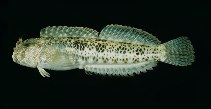| Family: |
Blenniidae (Combtooth blennies), subfamily: Salariinae |
| Max. size: |
11 cm TL (male/unsexed) |
| Environment: |
reef-associated; marine; depth range 0 - 3 m |
| Distribution: |
Indo-Pacific: East Africa to the Line and Ducie islands, north to the Ryukyu, Bonin, and Marcus islands (reported farther north to Wakayama Prefecture in Japan, Ref. 559), south to Lord Howe and Rapa islands. |
| Diagnosis: |
Dorsal spines (total): 12-14; Dorsal soft rays (total): 14-16; Anal spines: 2-2; Anal soft rays: 15-18. Small dark spots on body; upper lip uniformly dusky or with scattered spots; pale area behind eye followed by an irregular dark mark (Ref. 4404). |
| Biology: |
Adults occur in the intertidal zone of lagoons and wave-swept seaward reefs (Ref. 9710). They inhabit holes of limestone matrix at low tide (Ref. 90102). At low tide they may be found in small pockets of water left in pitted limestone. Oviparous. Eggs are demersal and adhesive (Ref. 205), and are attached to the substrate via a filamentous, adhesive pad or pedestal (Ref. 94114). Larvae are planktonic, often found in shallow, coastal waters (Ref. 94114). |
| IUCN Red List Status: |
Least Concern (LC); Date assessed: 27 March 2009 Ref. (130435)
|
| Threat to humans: |
harmless |
Source and more info: www.fishbase.org. For personal, classroom, and other internal use only. Not for publication.

